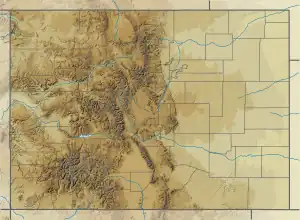Gravel Mountain
Gravel Mountain is a 13,596-foot-elevation (4,144-meter) summit in Hinsdale County, Colorado, United States. It is located nine miles (14 km) southeast of the community of Ouray, on land administered by the Bureau of Land Management. It is situated eight miles (13 km) west of the Continental Divide in the San Juan Mountains which are a subrange of the Rocky Mountains. Precipitation runoff from the mountain drains into Henson Creek which is part of the Gunnison River watershed.[3] Topographic relief is significant as the summit rises 2,800 feet (850 meters) above Henson Creek in approximately one mile (1.6 km). Access to the mountain is via the Alpine Loop Back Country Byway. The mountain's toponym has been officially adopted by the United States Board on Geographic Names,[2] and has been recorded in publications since at least 1906.[4]
| Gravel Mountain | |
|---|---|
 Northwest aspect | |
| Highest point | |
| Elevation | 13,596 ft (4,144 m)[1] |
| Prominence | 146 ft (45 m)[1] |
| Isolation | 0.39 mi (0.63 km)[1] |
| Coordinates | 37°57′35″N 107°32′28″W[2] |
| Geography | |
 Gravel Mountain Location in Colorado  Gravel Mountain Gravel Mountain (the United States) | |
| Country | United States |
| State | Colorado |
| County | Hinsdale |
| Parent range | Rocky Mountains San Juan Mountains[3] |
| Topo map | USGS Handies Peak |
| Climbing | |
| Easiest route | class 2[1] |
Climate
According to the Köppen climate classification system, Gravel Mountain is located in an alpine subarctic climate zone with cold, snowy winters, and cool to warm summers.[5] Due to its altitude, it receives precipitation all year, as snow in winter, and as thunderstorms in summer, with a dry period in late spring.
Gallery
See also
 Mountains portal
Mountains portal- Mountains of Hinsdale County, Colorado
- Thirteener
- Wood Mountain
References
- "Gravel Mountain - 13,596' CO". listsofjohn.com. Retrieved 2023-04-20.
- "Gravel Mountain". Geographic Names Information System. United States Geological Survey, United States Department of the Interior. Retrieved 2023-04-20.
- "Gravel Mountain, Colorado". Peakbagger.com. Retrieved April 20, 2023.
- Henry Gannett, United States Geological Survey (1906), A Gazetteer of Colorado, US Government Printing Office, p. 79.
- Peel, M. C.; Finlayson, B. L.; McMahon, T. A. (2007). "Updated world map of the Köppen−Geiger climate classification". Hydrol. Earth Syst. Sci. 11. ISSN 1027-5606.
External links
- Weather forecast: Gravel Mountain

